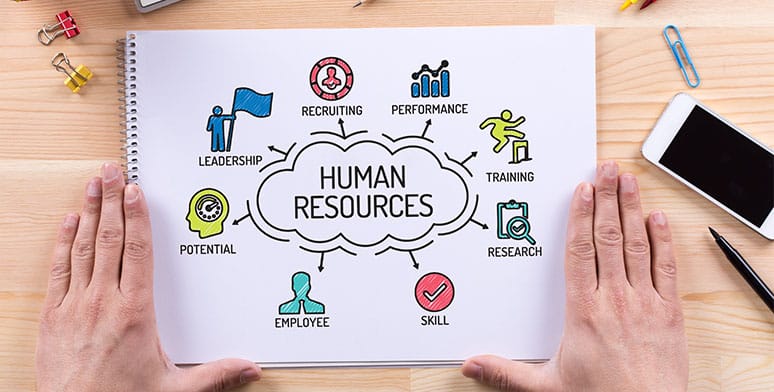Core Principles for Human Resources (HR) Professionals

Human Resource (HR) management is the process of effectively managing an organization’s workforce to achieve business objectives. For new – and even experienced – HR professionals, it can be useful to occasionally review the fundamentals of human resource management, to make sure you and your HR department are refreshed on the essential aspects of human resources.
What are Core Basic HR Functions of HR Management?
Core HR functions and management areas are essential in effectively supporting an organization’s workforce. These HR functions can be broadly categorized into the areas below. Many times, the basics of HR management are performed in partnership or collaboration with the supervisor or functional team.
Recruitment, Selection, and Staffing
- Job Analysis: HR can help supervisors describe the requirements of each job to create accurate job descriptions during the initial process of hiring new employees.
- Talent Acquisition: HR is often involved in the many steps needed to announce and fill open positions. This may include setting policy, identifying recruiting pathways and tools, writing job posts themselves, or setting up the systems through which supervisors do so.
- Sourcing Candidates: HR may also play a role in identifying potential candidates through different channels such as job postings, social media, recruitment agencies and employee referrals.
- Interviewing and Selection: While the Hiring Manager often leads selection, HR can play a partnering role, doing screening interviews or assessing candidates’ skills, experience and cultural fit through interviews, tests and reference checks to select the best match for the role.
Onboarding and Orientation: During the onboarding process, the basics of HR management is to integrate new employees into the organization by providing them with training, resources and information. HR plays a fundamental supportive role in introducing new hires to the organization to help them adjust and become productive. HR also generally covers personally sensitive items, like benefits, during onboarding.
Training and Development, and Workforce Planning
- Employee Training: Often, HR structures and provides internal and external training programs to develop specific skills and improve job performance.
- Professional Development: A larger HR team may provide other opportunities for continuous learning and career growth through workshops, coaching resources, certifications and mentorship programs.
- Leadership Development and Succession Planning: An HR team may provide assessments and development resources to identify and nurture future leaders within the organization. Advanced organizations also help define the organization’s approach to advancement or career ladder planning.
- Strategic Workforce Planning: HR may collaborate with leadership to engage in forecasting and planning for future staffing needs.
Performance Management
- Performance Appraisal System: It is often the responsibility of human resources to establish the general approach and procedures for the performance appraisal cycle. This may include helping to write performance plan language, providing templates, and setting due dates and documentation requirements for plans and appraisals.
- Performance Improvement Plans (PIPs): When there are performance problems, HR professionals can help address them by working with supervisors to create structured plans to help employees meet expectations.
Compensation and Benefits
- Salary Management: HR generally monitors and advises management on competitive salary and compensation structures that attract and retain talent, while monitoring internal equity.
- Benefits Administration: Part of managing compensation includes sourcing and managing employee benefits, including health insurance, retirement plans, leave and other benefits.
- Incentives and Rewards: HR, in consultation with management, will often develop and implement bonus or awards programs, and other incentive schemes to motivate employees.
Employee Relations
- Building a Positive and Engaging Work Environment: A HR principle is to help model a culture of respect, collaboration, and open communication, by noting any patterns across complaints and identifying points of needed intervention based on staff feedback.
- Conflict Resolution: When disputes or complaints occur, HR can play a role in navigating disputes between employees or between employees and management, or bringing in external mediation services if needed.
- Policy Development: Clear policies can help increase clarity and reduce conflict. HR can support this by creating and enforcing workplace policies and procedures.
Legal Compliance and Ethics: HR often has a key responsibility to make sure the organization complies with employment laws and regulations, such as those related to minimum wage, working hours and employee rights. As one of the basics of HR management, human resources identifies and mitigates risks related to employee relations and workplace dynamics (e.g., anti-harassment programs, programs to support accommodations for people with disabilities). HR can also promote ethical behavior and establish and promote the organization’s code of conduct.
SAVE $10 AND TRAIN ON THIS TOPIC TODAY
HR Information Systems and Data Management: The HR team generally manages HR-related systems and data. This includes employee information, payroll, benefits, attendance records and other HR-related information. An advanced HR team is able to report and analyze data to help the business make informed decisions related to people, like projected salaries, attrition rates and HR process improvements.
Health, Safety and Wellbeing: One tool of HR is to provide information for building a safe working environment and making sure the team complies with occupational health and safety standards. Sometimes, this fundamental HR element is handled by an operations or compliance team instead. This core principle of human resources also includes promoting the physical, mental, and emotional well-being of employees through services like Employee Assistance Programs (EAP) and wellness events. EAPs provide confidential counseling and services for employees with personal or work-related challenges.
Diversity, Equity, and Inclusion (DEI)
- Promoting Diversity: Sometimes, a DEI Office is separate from HR, but it is often part of it. HR plays a critical role in seeking ways to grow a diverse talent pool – for the present and future.
- Inclusive Practices: HR can also model ways to promote a diverse workforce and inclusive workplace culture through events and employee highlights.
- Equity Initiatives: HR also monitors patterns across the organization to ensure fair treatment, access and opportunity for all employees. They are often well positioned to address disparities and emphasize areas where more fairness is needed.
Termination and Offboarding: HR often conducts exit interviews with departing employees to gain insights into why they are leaving – patterns can highlight improvement needs. HR professionals generally handle the logistics of employee exits, such as gathering equipment and keys, and providing information about final pay and benefits transitions.
These core functions work together to support the organization’s overall strategy, helping to build a workforce that is productive, engaged and aligned with business goals.
Six Key Principles of Human Resource (HR) Management
The areas above reflect the roles and activities of HR professionals. There is also a core set of principles that should guide this work.
- Strategic Alignment: HR practices should align with the organization’s goals and objectives. HR needs to directly support the overall strategy, and its practices should reflect that.
- Partnership and Engagement with Business and Operations: While many HR tasks seem transactional, operating in partnership with supervisors and functional leadership helps add and show value.
- Fairness, Equity and Objectivity: HR principles emphasize fairness in all practices, including hiring, promotions, compensation, and discipline. Ensuring equity helps build trust and reduce discrimination and bias.
- Communication: Effective communication within the organization fosters transparency, resolves conflicts, and keeps employees informed about company policies, changes and expectations.
- Innovation and Adaptability: HR professionals need to be proactive and adaptable to changes in the business environment, technology and workforce expectations. This includes embracing new HR practices and technologies to improve efficiency and effectiveness.
- Ethics: HR teams act with integrity, maintain confidentiality and develop HR practices that reflect the organization’s values.
These human resource principles help create a structured approach to managing people in a way that supports organizational success and fosters a positive work environment.
Capturing Practices and Principles: Building a HR Guide
An HR Guide is a useful resource for HR professionals, managers and employees to provide clear guidance on HR policies and procedures. If you are a new HR professional, ask for your organization’s guide. Or you may be asked to write one! Many key elements of such a guide align with the topics on HR management listed above. Here’s a quick HR Guide roadmap:
- Introduction: Purpose and Scope, Mission and Values
- Employment Policies
- Recruitment and Hiring
- Compensation and Benefits
- Performance Management and Appraisals
- Training and Development
- Employee Relations (Communication Channels, Grievance Procedures)
- Workplace Code of Conduct and Ethics Codes
- Health, Safety, and Wellbeing
- Compliance Documentation and Legal References
- Workplace Diversity and Inclusion
- Technology and Tools; IT Policies
- HR Metrics and Reporting including Key Performance Indicators (KPIs)
- Appendices (Glossary, Forms and Templates, Resources)
These elements form the backbone of an effective HR Guide, providing clear, accessible, and comprehensive information to support human resources functions to help develop a positive employee experience and boost corporate productivity.
HR Training Opportunities
Pryor offers many resources to Human Resource (HR) professionals charged with training development and many other tasks. In addition to several blog articles about training development, check out other Pryor offerings:
- Comprehensive Training for HR Managers
- Set Employee Goals and Define Performance Expectations
- How to Conduct Employee Performance Evaluations
- Dealing with Employee Discipline & Performance Problems
- Communicating with Tact and Professionalism
- Training the Trainer
- Establishing a Powerful Mentoring Program
- Successful Employee Onboarding






